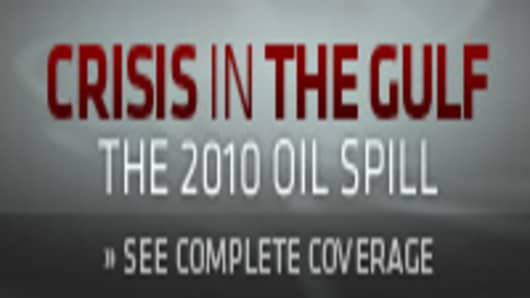The U.S. Department of Interior confirmed Tuesday that oil has been leaking from a non-BPwell into the Gulf of Mexico, but put the size of the leak at less than a barrel a day.
"Small amounts of oil—an average of less than one-third of a barrel per day—have been leaking" from wells operated by privately held oil exploration company Taylor Energy, the Interior Department said late Tuesday.
Taylor confirmed the leak in a statement after markets closed, but called it "minimal" and said the resulting oil sheen never made landfall.
The company also refuted earlier reports that the drilling rig Ocean Saratoga, owned by Diamond Offshore and operated by Taylor, was the source of the leak.
Rather, the oil appeared to come from an old production platform site that was destroyed by a subsurface mudslide in 2004, after the Gulf was hit by Hurricane Ivan. Taylor has subsequently deployed three subsurface containment domes at the site.
"Unidentified aircraft took photos this weekend that incorrectly reported an oil leak coming from the drilling rig Ocean Saratoga," Taylor said in a statement. "At the time of these photos, Taylor Energy was actually conducting marine operations on site with a 180 foot dynamically positioned workboat for a regularly scheduled subsea containment system drainage.
"The tanks mistakenly characterized as containing dispersants on the boat’s deck, were actually tanks to store and transport the collected oil as it was pumped from the underwater storage system," the company added.
Ocean Saratoga is located about 12 miles off the tip of Louisiana in about 500 feet of water.
Speculation has been growingabout whether the massive oil slicks choking the Gulf have resulted solely as a result of BP's gushing Deepwater Horizon oil rig, which exploded in April.
Amid the chatter, an Alabama newspaper, The Press Register, reported that Ocean Saratoga has been leaking since April 30. That report, coupled with a video taken of the drilling rig, fanned fears that there are multiple wells leaking into the gulf.
Those concerns, along with the expectation that drillers will face increasing scrutiny in the months ahead, sent shares of Diamond Offshore and other oil-services stocks lower Tuesday.
Diamond Offshore CFO Gary Krenek said the oil-services company was hired byTaylor Energy, but he declined to comment on the reported leak, referring all calls to Taylor.
Certification of 'Blowout Preventers' Coming
In addition to clarifying reports about the leak, the Interior Department issued stronger safety requirements that must be met in order to carry out offshore drilling operations in shallow waters of less than 500 feet deep.
Before beginning any new drilling operations, companies must certify that they have working blowout preventers to avoid oil spills, that they will conduct at least two tests of cement barriers in underwater wells and that they will follow new casing installation procedures.
Drilling operators have until June 17 to meet the blowout preventer requirements and must submit their required safety certifications by June 28 or face a shut-in order by the department.
The tightened regulations come as the Obama administration faces increased criticism about how it has handled the aftermath of the Deepwater Horizon explosion. That well was in deep water, and would not have been impacted by these new requirements.
The shallow waters of the Gulf account for the majority of the natural gas produced in the region, but only a small portion of the oil that comes from the region.




